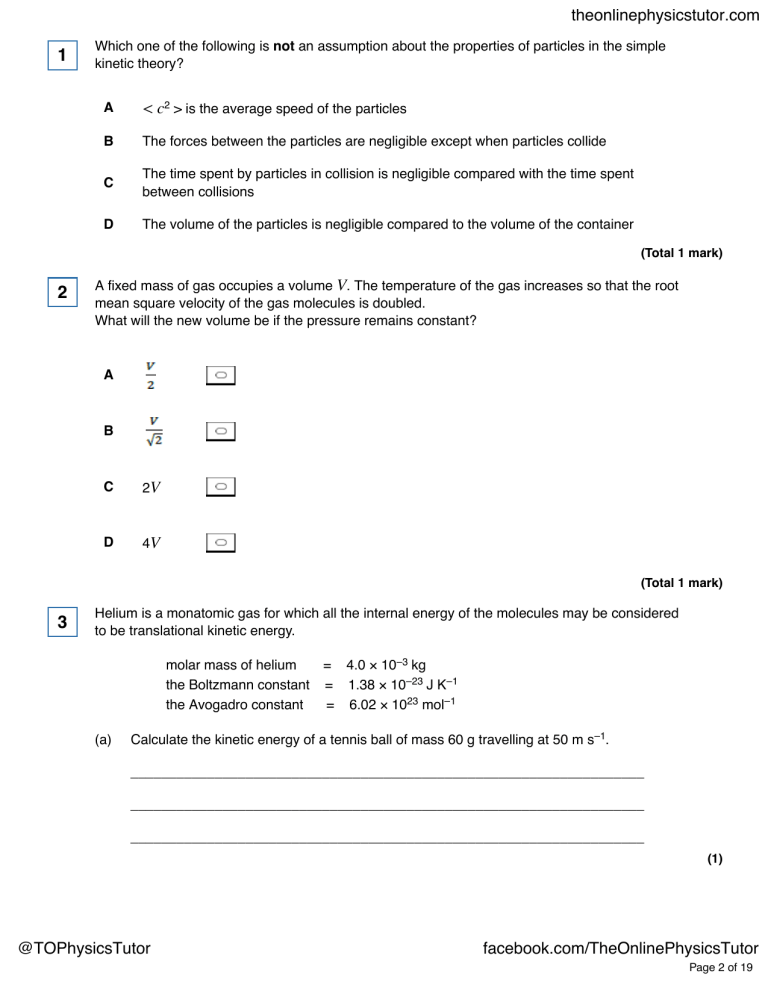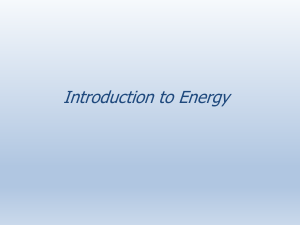
theonlinephysicstutor.com 1 Which one of the following is not an assumption about the properties of particles in the simple kinetic theory? A < c2 > is the average speed of the particles B The forces between the particles are negligible except when particles collide C The time spent by particles in collision is negligible compared with the time spent between collisions D The volume of the particles is negligible compared to the volume of the container (Total 1 mark) 2 A fixed mass of gas occupies a volume V. The temperature of the gas increases so that the root mean square velocity of the gas molecules is doubled. What will the new volume be if the pressure remains constant? A B C 2V D 4V (Total 1 mark) 3 Helium is a monatomic gas for which all the internal energy of the molecules may be considered to be translational kinetic energy. molar mass of helium = 4.0 × 10–3 kg the Boltzmann constant = 1.38 × 10–23 J K–1 the Avogadro constant = 6.02 × 1023 mol–1 (a) Calculate the kinetic energy of a tennis ball of mass 60 g travelling at 50 m s–1. ___________________________________________________________________ ___________________________________________________________________ ___________________________________________________________________ (1) @TOPhysicsTutor facebook.com/TheOnlinePhysicsTutor Page 2 of 19 theonlinephysicstutor.com (b) Calculate the internal energy of 1.0 g of helium gas at a temperature of 48K. ___________________________________________________________________ ___________________________________________________________________ ___________________________________________________________________ ___________________________________________________________________ ___________________________________________________________________ ___________________________________________________________________ (3) (c) At what temperature would the internal energy of 1.0 g of helium gas be equal to the kinetic energy of the ball in part (a). ___________________________________________________________________ ___________________________________________________________________ (1) (Total 5 marks) Figure 1 4 Figure 1 shows a cylinder, fitted with a gas-tight piston, containing an ideal gas at a constant temperature of 290 K. When the pressure, p, in the cylinder is 20 × 104 Pa the volume, V, is 0.5 × 10–3 m3. @TOPhysicsTutor facebook.com/TheOnlinePhysicsTutor Page 3 of 19 theonlinephysicstutor.com Figure 2 shows this data plotted. Figure 2 (a) By plotting two or three additional points draw a graph, on the axes given in Figure 2, to show the relationship between pressure and volume as the piston is slowly pulled out. The temperature of the gas remains constant. (3) (b) (i) Calculate the number of gas molecules in the cylinder. answer = ______________________ molecules (2) @TOPhysicsTutor facebook.com/TheOnlinePhysicsTutor Page 4 of 19 theonlinephysicstutor.com (ii) Calculate the total kinetic energy of the gas molecules. answer = ______________________ J (3) (c) State four assumptions made in the molecular kinetic theory model of an ideal gas. (i) ______________________________________________________________ ______________________________________________________________ (ii) ______________________________________________________________ ______________________________________________________________ (iii) ______________________________________________________________ ______________________________________________________________ (iv) ______________________________________________________________ ______________________________________________________________ (4) (Total 12 marks) 5 The diagram below shows a number of smoke particles suspended in air. The arrows indicate the directions in which the particles are moving at a particular time. (a) (i) Explain why the smoke particles are observed to move. ______________________________________________________________ ______________________________________________________________ (1) @TOPhysicsTutor facebook.com/TheOnlinePhysicsTutor Page 5 of 19 theonlinephysicstutor.com (ii) Smoke particles are observed to move in a random way. State two conclusions about air molecules and their motion resulting from this observation. ______________________________________________________________ ______________________________________________________________ ______________________________________________________________ ______________________________________________________________ (2) (b) A sample of air has a density of 1.24 kg m–3 at a pressure of 1.01 × 105 Pa and a temperature of 300 K. the Boltzmann constant = 1.38 × 10–23 J K–1 (i) Calculate the mean kinetic energy of an air molecule under these conditions. (2) (ii) Calculate the mean square speed for the air molecules. (3) (iii) Explain why, when the temperature of the air is increased to 320 K, some of the molecules will have speeds much less than that suggested by the value you calculated in part (b)(ii). ______________________________________________________________ ______________________________________________________________ ______________________________________________________________ ______________________________________________________________ (2) (Total 10 marks) @TOPhysicsTutor facebook.com/TheOnlinePhysicsTutor Page 6 of 19 theonlinephysicstutor.com 6 (a) Write down four assumptions about the properties and behaviour of gas molecules which are used in the kinetic theory to derive an expression for the pressure of an ideal gas. Assumption 1 ________________________________________________________ ___________________________________________________________________ Assumption 2 ________________________________________________________ ___________________________________________________________________ Assumption 3 ________________________________________________________ ___________________________________________________________________ Assumption 4 ________________________________________________________ ___________________________________________________________________ (4) (b) (i) A cylinder, fitted with a pressure gauge, contains an ideal gas and is stored in a cold room. When the cylinder is moved to a warmer room the pressure of the gas is seen to increase. Explain in terms of the kinetic theory why this increase in pressure is expected. ______________________________________________________________ ______________________________________________________________ ______________________________________________________________ ______________________________________________________________ ______________________________________________________________ ______________________________________________________________ (ii) After a time, the pressure of the gas stops rising and remains steady at its new value. The air temperature in the warmer room is 27°C. Calculate the mean kinetic energy of a gas molecule in the cylinder. ______________________________________________________________ ______________________________________________________________ ______________________________________________________________ ______________________________________________________________ (6) (Total 10 marks) @TOPhysicsTutor facebook.com/TheOnlinePhysicsTutor Page 7 of 19 theonlinephysicstutor.com 7 (a) The molecular theory model of an ideal gas leads to the derivation of the equation Explain what each symbol in the equation represents. p _________________________________________________________________ V _________________________________________________________________ N _________________________________________________________________ ___________________________________________________________________ m _________________________________________________________________ ________________________________________________________________ ___________________________________________________________________ (4) (b) One assumption used in the derivation of the equation stated in part (a) is that molecules are in state of random motion. (i) Explain what is meant by random motion. ______________________________________________________________ ______________________________________________________________ ______________________________________________________________ (ii) State two more assumptions used in this derivation. ______________________________________________________________ ______________________________________________________________ ______________________________________________________________ ______________________________________________________________ (3) @TOPhysicsTutor facebook.com/TheOnlinePhysicsTutor Page 8 of 19 theonlinephysicstutor.com (c) Describe how the motion of gas molecules can be used to explain the pressure exerted by a gas on the walls of its container. ___________________________________________________________________ ___________________________________________________________________ ___________________________________________________________________ ___________________________________________________________________ ___________________________________________________________________ ___________________________________________________________________ (4) (Total 11 marks) 8 The table gives the average kinetic energy of gas molecules at certain temperatures. Ek/J × 10–21 6.21 6.62 7.04 7.45 7.87 8.28 T/K 300 320 340 360 380 400 @TOPhysicsTutor facebook.com/TheOnlinePhysicsTutor Page 9 of 19 theonlinephysicstutor.com (a) On the grid provided below plot a graph of Ek against T. (i) Use your graph to determine the average kinetic energy of gas molecules at 350K. ______________________________________________________________ @TOPhysicsTutor facebook.com/TheOnlinePhysicsTutor Page 10 of 19 theonlinephysicstutor.com (ii) Determine the gradient of your graph and hence calculate a value for the Boltzmann constant. Show all your working. ______________________________________________________________ ______________________________________________________________ ______________________________________________________________ ______________________________________________________________ ______________________________________________________________ ______________________________________________________________ (8) (b) One of the assumptions of the kinetic theory is that collisions of gas molecules are elastic. (i) State what is meant by an elastic collision. ______________________________________________________________ ______________________________________________________________ ______________________________________________________________ (ii) State another assumption of the kinetic theory. ______________________________________________________________ ______________________________________________________________ (iii) Explain how the data in the table leads to the concept of absolute zero. ______________________________________________________________ ______________________________________________________________ ______________________________________________________________ ______________________________________________________________ (4) (Total 12 marks) @TOPhysicsTutor facebook.com/TheOnlinePhysicsTutor Page 11 of 19





